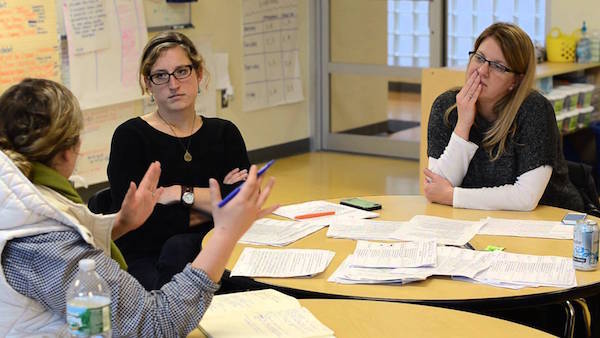 By Jill A. Edwards
By Jill A. Edwards
Instructional Partner
Florence Middle School
Florence City (AL) Schools
How often does a teacher intentionally assign something to students with little or no thought, care, or belief that the task is beneficial? The answer to this is almost never! Teachers work hard to provide quality instruction.
However, sometimes intention and reality conflict. Taking the time to look at the work our students produce in response to our assignments provides an opportunity to calibrate and refine the level, quality, and explanation of the work we ask them to do.
One way to do this is to gather with other teachers and use a protocol to examine sample student work products. Of course, teachers look at student work every day. But when teachers are asked to collaborate and share their observations about a variety of assignments, the impact can be astounding.
While the idea of sharing in this way may feel uncomfortable at first, consider that when student work is brought to the table, one benefit is the opportunity to really reflect on the standards the assignment is intended to assess versus the expectations of the assignment itself.
Putting the LASW Protocol on the table
Recently, I asked our teachers to use the CCR Standards and the LASW protocol from the National School Reform Faculty website titled “Standards & Looking at Student Work”.
Our teachers meet collaboratively regularly, but the use of a protocol has helped give meaning and purpose to these meetings, and has provided an opportunity to focus on student work. This particular protocol asks teachers to really hone in on what the expected outcome is of the assignment, and to compare what is being asked to what result is hoped.
This is deepened even further when the depth of knowledge (Webb’s) or taxonomy (Bloom’s) is used to compare and contrast the rigor of the task to the standard.

I sat in on a session with a group of teachers who were looking at a project based assignment. As the teacher spoke about the assignment, it sounded very interesting and well thought out. The teacher had a rubric for the students as well.
However, when using the protocol, the teacher was asked to identify the standards for the assignment. It became apparent in the discussion that although it was a great activity, the teacher had not thought about the assignment being an assessment of specific standards that had recently been taught.
Instead, the teacher was thinking about all of the many standards that could be listed as being a part of the project. While this method works for our students who already possess the skills, it is not an effective method for our students who have not yet mastered the particular standard.
Looking at the differences in outcomes
In addition, when multiple work samples are brought to the table, there can be rich discussion in regard to the reasons for a difference in the outcome by different students.
Questions that this can bring to mind, particularly when the work samples show a marked difference in level of comprehension include (but are not limited to): Were the directions clear and concise? How explicit were the expectations? Was a rubric used to outline the guidelines for the assignment?
In the group discussion above, the teachers determined that although a rubric was used, the criteria were vague and subject to (mis)interpretation by the students. Teachers also discussed the importance of breaking up the assignment to include mini-checks to make sure the students were on the right track.

Comparing writing samples
In another session, a teacher brought three work samples from a recent writing assignment. At a glance, it was easy to see a marked difference in the “quality” of the work by the students. One student wrote a full page, another student a lengthy paragraph, and a third student wrote a few sentences. Without the protocol, grading was easy, and the grades were, for the most part, based on length of response.
However, when asked to look at this student work using the protocol, a rich discussion ensued. The assignment was designed for students to research a topic and write about four specific components. When we read the three samples, all three papers met this criteria, although the teacher was not satisfied with the outcome of two of the three samples.
A rubric was not provided initially, and it became clear in the conversation that without clear guidelines, the students were left to interpret the expectations on their own.
By using the work samples as a guide, we were able to craft a rubric that was much more explicit. Often students are labeled as lazy or unmotivated, when in reality, they are simply being brief and concise and giving us exactly what we ask for – but not necessarily what we expect.
Powerful professional learning that benefits students
As an Instructional Partner, the use of a Student Work Protocol has helped me open the door to conversation that previously made me uncomfortable. The protocol also makes this more teacher-driven rather than led by me. This creates a powerful experience for everyone involved. When teachers learn from each other, and from student work, everyone benefits.
Jill Edwards is the Instructional Partner at Florence Middle School (Grades 7 & 8) in the Florence (AL) City Schools. Jill was previously the IP at Florence City’s Hibbett MS and has worked in education for 12+ years across the K-8 spectrum.
_____________________
Additional resource:

April 2015, Teachers College Press
Amazon description: “This bestseller provides teachers and administrators with strategies for examining and discussing student work, such as essays, math problems, projects, artwork, and more. New for the Third Edition: The Microlab Protocol, a relatively quick and easy way to introduce groups to protocol-guided conversation; a new case focused on understanding the Common Core; and more detailed notes and strategies for facilitators.”

0 Comments on "The Benefits of Teachers “Looking at Student Work” Together"